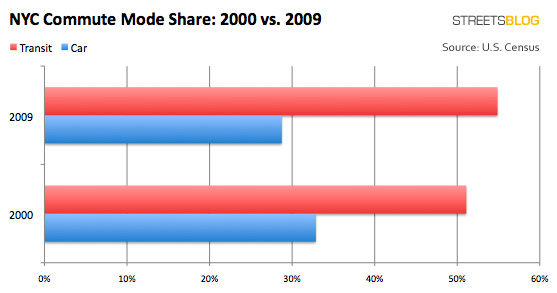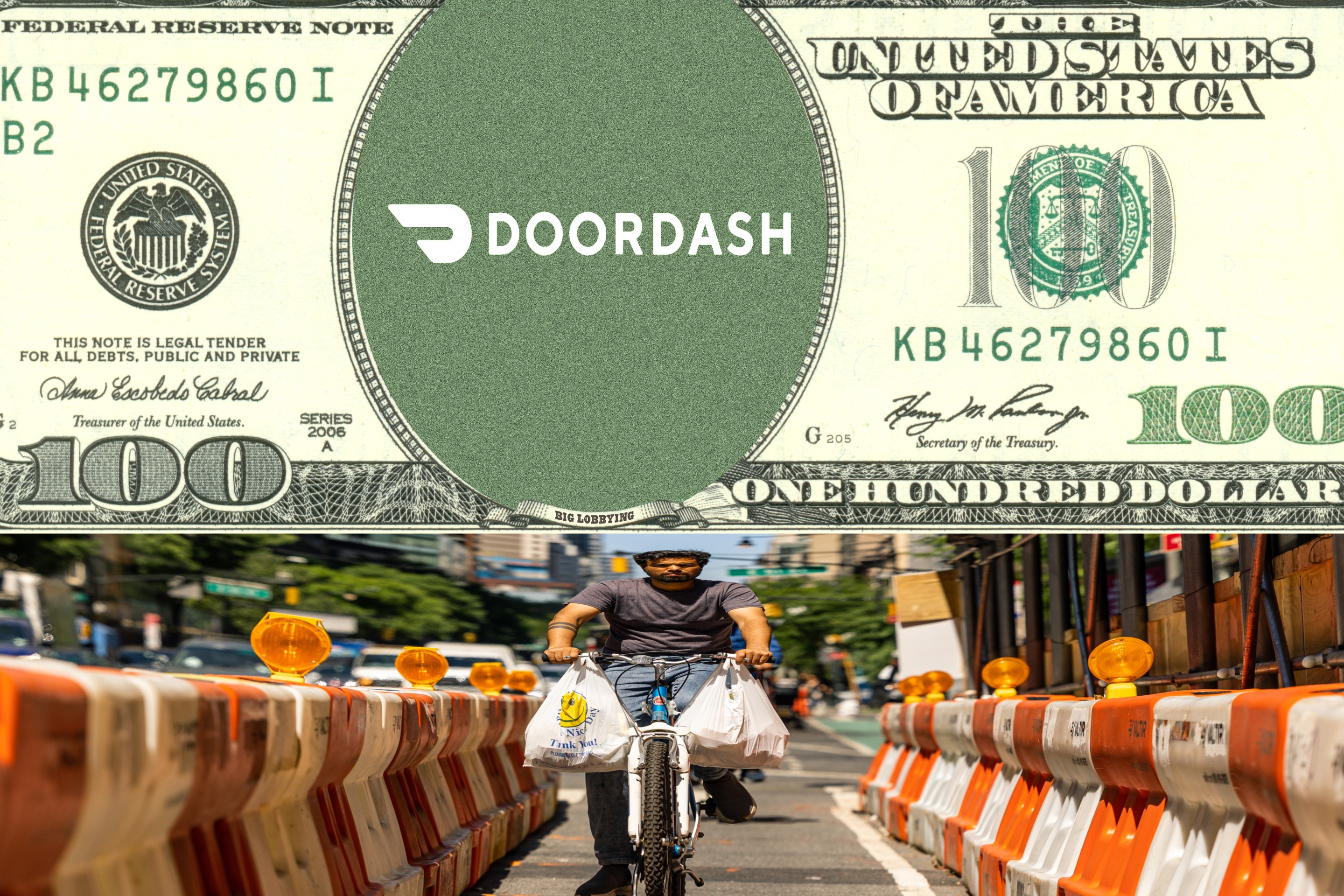
Significantly more New Yorkers are counting on trains and buses to get to work than at the beginning of the decade, according to new information from the U.S. Census. The data confirms the trend toward transit identified in NYC DOT's Sustainable Streets Index and offers a fascinating portrait of how New Yorkers' commute habits have changed in the last 10 years. Streetsblog's analysis shows that commuters are shifting away from the automobile across the state.
With the recent release of this Census data, it's finally possible to get fine-grained stats that can be compared to the 2000 Census. That means a wealth of new information about how people in different parts of New York get to work. Looking through the data, one thing jumps out: Transit-rich New York City is leading the way in a shift toward more sustainable transportation.
To crunch the numbers, we put together a spreadsheet, which you can download here (warning: the formatting is still a little rough around the edges), comparing the new data to information from the 2000 Census. It shows the change in commuting patterns in all the state's legislative districts. One caveat: this data is from 2005 through 2009, so it includes boom times and the recession, and does not reflect any changes caused by this year's transit cuts.
The percentage of commuters who drive to work decreased in 134 out of 150 Assembly districts, and 57 out of 62 State Senate districts. All of these districts saw shifts toward transit, walking, or working from home. Across the state, the share of commuters who drive to work fell from 65.5 percent in 2000 to 61.6 percent in 2009, a sizable shift. In New York City, the number fell from 32.9 percent to 29 percent.
The biggest shifts toward sustainable transportation occurred in the Bronx, Brooklyn, and Queens. Here are the most significant changes in individual Assembly districts, which occurred in neighborhoods where relatively few people drove to work in the first place:
- In Fordham rep José Rivera's district, driving mode share decreased from 29.3 percent to 21.9, a shift of 7.5 percentage points. Just under 700 fewer commuters drove to work, while around 7,500 more took transit, 850 more walked to work and 1,000 more worked from home.
- In 2000, 35 percent of Alec Brook-Krasny's Bay Ridge and Brighton Beach constituents drove to work. Now less than 28 percent do.
- Driving mode share dropped from 29 percent to 21.7 percent in Michael Gianaris's Astoria district.
- The districts of East New York reps Darryl Towns and Inez Barron took the next two spots. The percentage of commuters who drove to work dropped from 31 percent to 24.1 percent and from 34.3 percent to 27.5 percent, respectively.
In State Senate districts, these were the largest shifts:
- In Transportation Committee chair Martin Dilán's Bushwick district, the percentage of commuters driving fell from 24.7 percent to 18.3, a shift of 6.4 percentage points. Though the total number of people driving to work actually increased by a few hundred people, that was swamped by a massive 29,000 new transit commuters.
- Driving mode share in Joseph Addabbo's Southern Queens district dropped from 49.5 percent to 43.6 percent.
- The next largest drops took place in the former districts of bridge toll-killing amigos Pedro Espada and Hiram Monserrate. Driving fell from 28.3 percent to 22.5 percent of commutes in Espada's former district (now represented by Gustavo Rivera), and from 28.7 percent to 23 percent in Monserrate's old stomping grounds (now José Peralta's). Relying on 2000 Census data, we knew that Espada and Monserrate were poorly representing their largely transit-riding constituents when they obstructed bridge tolls, but even fewer of their district's residents drove to work than we realized.
There were a few districts where driving made up a larger share of trips than in 2000.
- In Dede Scozzafava's North Country district, by the Canadian border, driving rose from 85.6 percent of trips to 90.8 percent of trips.
- Two Long Island districts, represented by Earlene Hooper and Ginny Fields, also saw increases in car commuting. Driving mode share rose from 71.5 percent to 73.7 percent in Hooper's district, and from 90 percent to 90.9 in Fields'.
In Scozzafava's district, the rise in driving came at the expense of trips made by walking to work. Perhaps with more compact development and complete streets that are safe for walking, that decline needn't have happened over the decade.
The percentage of commuters driving to work increased in only two New York City districts, both on Manhattan's West Side. In Deborah Glick and Richard Gottfried's transit-rich districts, driving to work is relatively rare. The change in how their constituents get to work reflects that: There are more new commutes on transit than in cars. But the growth in commuting is weighted more toward driving than the transit/car split in 2000, meaning the districts are starting to become slightly more auto-oriented: Car commuting increased 0.5 percentage points in Glick's district and 0.2 in Gottfried's. Perhaps one culprit is the glut of new parking that continues to be approved in the area, despite often-disregarded Clean Air Act restrictions on parking south of 60th Street.
While the mode share numbers show transit gaining on driving, looking at absolute changes, the number of car commuters in the state has risen, and some New York City districts saw sizable jumps. For issues like traffic congestion, where the total volume of cars on the road is the relevant question, that's bad news.
Senator Andrew Lanza's Staten Island district saw 5,000 more people driving to work (and more new cars than that, as 2,700 fewer people were carpooling). Malcolm Smith's Southeast Queens district saw 8,000 more commuters driving alone. The fastest growth in car commuting happened on the eastern tip of Long Island; Senator Kenneth Lavalle's district saw around 17,500 new people driving to work.
In terms of total transit use, the map of major increases is very similar to the map of mode share jumps. The largest increases in transit commuting came in the districts of Senators Dilan, Bill Perkins (Harlem), José Serrano (South Bronx/East Harlem), Peralta, and Rubén Díaz (Longwood). The biggest decreases in transit ridership came along the southern coast of Suffolk County, in Senator Owen Johnson and Assembly Member Ginny Fields' districts.
Only one New York City district saw an absolute decrease in the number of transit riders -- Jonathan Bing's on the Upper East Side -- but that appears to be due to a decrease in the total number of commuters.
Let us know in comments what you find in the new Census data. Any patterns jump out at you? Any legislators who need to know their district is changing?





